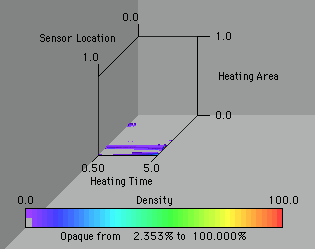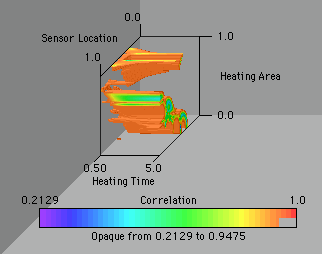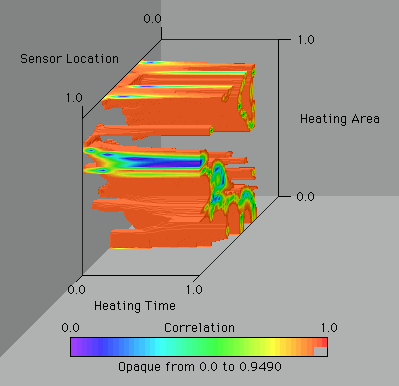Overview
Problem Description
When new materials are invented the thermophysical properties of the material are usually unknown. For example, our research group is frequently interested in estimating the thermophysical properies of new composites that exhibit anisotropic behavior. To estimate the properties we must design an experiment that will give us the best results. A typical experimental optimization procedure is extremely complicated and usually is performed using a parametric approach, and only one criterion (for determining the "best" experiment) is used.
Ideally we want to make a temperature measurement in time at a single location on the unknown material. This temperature measurement is then used to extract (hopefully) the properties of thecomposite. A mathematical model of two dimensional conduction is used to calculate sensitivities of a calculated temperature to the thermophysical properties at a specific design point. If we visit a sufficiently large number of design points we can construct a parametric data set. For each design point we can generate a 3x3 symmetric sensitivity matrix (we have 3 thermophysical parameters in our problem). This matrix is then manipulated and visualized to show the optimum design point.
What are we looking for?
- To minimize the confidence region
- To reduce correlation
Minimization of the Confidence Region
The e-criteria
The confidence region should be minimized and one method for accomplishing this is to find the region where the confidence region has the smallest volume. Therefore, by locating the design whose determinant is smallest, we have effectively minimized the volume of the confidence region.The d-criteria
Another method for minimizing the confidence region is to minimize the trace. Now the optimal experimental design will produce results whose confidence intervals are smallest. Note however, this may not be the location of smallest volume.The a-criteria
In both previous paradigms, a single sensitivity might be large while the others are small. Looking at the determinant and/or the trace can give a "smoothed" result. If we are primarily interested in a single parameter we can examine the appropriate diagonal term independently of the rest. This experimental design will be optimal for estimating the parameter of interest.
Correlation
Results

We see that there is not a large region that is more sensitive than most of the design space. Using this criteria in a gradient method might lead us to believe that we have a profoundly better design, when in fact it may not be. This also demonstrates that another design criteria might yield a wider choice of designs. The fact that the possible designs are so sparce indicates that we will probably have a hard time generating an adequate experiment to estimate the desired parameters accurately and independently. More analysis is needed before we make such a conclusion, however.
If we want to determine the level of correlation we can visulaize the maximum off-diagonal term in the R matrix. The values above 0.95 have been eliminated to give regions of "low-enough" correlation.

Something that has been impossible without this form of parametric study and visualization is to determine where the parameters are correlated. Historically the correlation is checked after a design is selected. If the parameters turn out to be correlated, the experimental design had to be re-thought. This picture shows us the regions where we can estimate parameters independently. Notice that the correlation is independent of heating time. This same result can be nearly obtained from the image of the maximum trace. This would suggest that a follow up analysis might not include heating time as an experimental parameter to be used to design a better experiment.
To demonstarte another approach to the problem, suppose that we are only interested in studying a single parameter after the exepriment. We can then examine the correlation of this parameter with the other two. Instead of visualizing the max off-diagonal term, we can look at the appropriate off-diagonal term.

Since the images are similar we can assume that the parameter chosen in this case dominates the correlation of the whole system. Never the less, we can locate a design point that sufficiently uncorrelates the parameters.
Conclusions
Acknowledgements
- Dr. Ron Kriz - visualization
- Gordon Miller - presentation
- Joe Hanak and Debbie Moncman - previous work on this problem